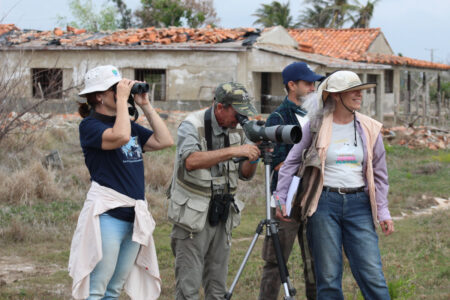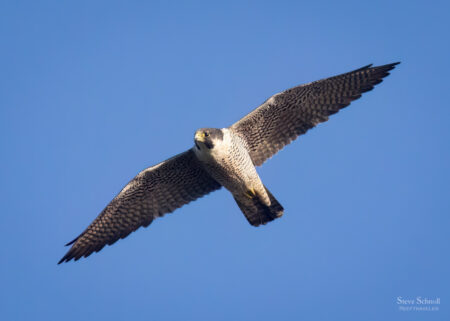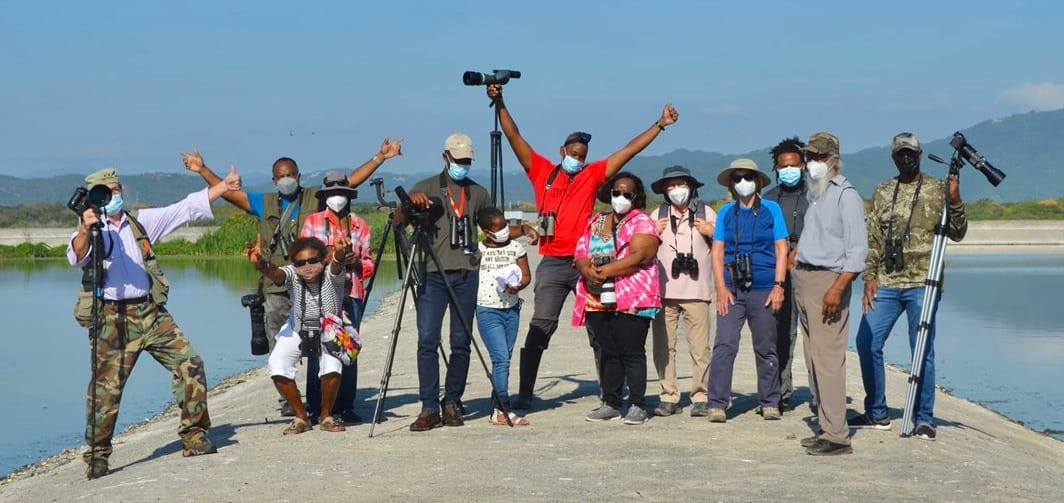
2023 is the 14th year of our annual Caribbean Waterbird Census (CWC) regional count. Many of our dedicated friends and colleagues got out and about in our wonderful wetlands, all across the Caribbean, to count waterbirds! This year we asked people to make a special effort to find wintering Piping Plovers. Many of you did just that and plenty of other beautiful birds were encountered during the three-week count period. Read on to hear about where Piping Plovers were seen (or not!) and for some highlights from around the islands. Every single survey makes an important contribution and we are so grateful to everyone who took part in our 2023 CWC!
Waterbirds delight both visitors and locals on Bonaire
In Bonaire Susan Davis tells us that the amazing waterbirds of this island did not disappoint. During the CWC 2023, bird enthusiasts who flocked to Bonaire were treated to a breath-taking sight. At the famed “Flamingo Island” visitors got to witness the awe-inspiring breeding colony of American Flamingos from afar. The magnificent birds were in the midst of their breeding season, building mud nests and raising their single chick. Although the breeding area is strictly off-limits, birders had plenty of opportunities to observe other coral-colored flamingos up close and appreciate their beauty.
Hover over photos for captions & click to enlarge the images
Visiting birders were also thrilled to spot the rare Great White Heron, which has become something of a celebrity on the island. Fondly referred to as “Big Bird” by local birders, the white morph of the Great Blue Heron is considered quite rare outside Florida or Cuba. Susan tells us that it has been on Bonaire for a year now!
As if that wasn’t enough, local birders had been keeping a close eye on a nesting site of Reddish Egrets since early September. During the 2023 CWC two chicks now 14-weeks old were present. The chicks had learned to forage on their own, but they still acted like “children” whenever one of their parents returned to the nest. The entire experience was a joy to behold, and birders left Bonaire with memories that will last a lifetime!

Caren Eckrich, who is a Biologist with STINAPA on Bonaire, carries out CWC counts quarterly through the year. She tells us that during this past year there has been more rain than normal and that the salinas were incredibly full. CWC surveyors noticed the difference this made in the species and abundances of birds in the different salinas. Highlights during the regional count included some rare finds and several birds of prey. Merlins, Ospreys, Crested Caracaras and, best of all, Peregrine Falcons were all seen hanging around the salinas in Washington Slagbaai Park. Caren’s favorite find during her CWC counts, was a shy Sora spotted in Salina Tam where she had never seen this bird before!
Flocking together and flying solo in Jamaica
Several small groups of BirdLife Jamaica members counted waterbirds during the CWC, and others did solo counts at several sites across the island. Jamaica is currently entering a drought period; nevertheless, the birds of Port Royal, at the entrance to Kingston Harbour, were enjoying life with the fisherfolk and begging for scraps. These included Snowy Egrets, Brown Pelicans, Ruddy Turnstones, and Black-bellied Plovers. On the Harbour itself, Royal Terns and a host of Laughing Gulls were seen; one Royal Tern was banded. On the North coast, at the mouth of the White River Fish Sanctuary, there were night herons, egrets and Common Gallinules a-plenty.
Hover over photos for captions & click to enlarge the images
One intrepid birder, in search of more unusual species, was rewarded with a Grasshopper Sparrow and West Indian Whistling-Ducks in two wetland locations, a Yellow-breasted Crake, Masked Duck, and three species (Green-winged Teal, Ring-necked Duck and Lesser Scaup) were at Montego Bay Sewage Ponds. Sewage ponds are a favorite spot for waterbird spotting!

Picking up a Pelican in Puerto Rico
BirdsCaribbean President Adrianne Tossas shared some of her CWC 2023 experiences on social media. She carried out waterbird surveys at the mouth of the Anasco River.
On their way to survey Aguadilla Bay the survey team picked up a feathered friend on their boat-ride to get to the survey site!
Hover over photos for captions & click to enlarge the images
Celebrating wetlands in the Dominican Republic
In northwestern DR Maria Paulino and her team from Grupo Acción Ecológica (GAE) continued their long-term CWC monitoring of the wetlands of Monti Cristi National Park. GAE’s repeated visits to this important wetland complex are vital, not just to count the birds but also to continue to identify threats to these wetlands. As part of their work in this area the group continue to remove illegal snare traps. These are set to capture flamingos, which are then sold to hotels, but are of course a threat to many other wetland birds.
Hover over photos for captions & click to enlarge the images
As part of GAE’s outreach work to raise awareness about wetlands and the special birds that use them, Maria and the team celebrated World Wetlands Day (February 2nd) with the children of Jose Garbriel Garcia Primary School in Monte Cristi. The children learned all about wetland birds and were then delighted to venture out to see them for themselves at the Estero Balsa wetlands.
Hover over photos for captions & click to enlarge the images
In search of Piping Plovers in Cuba
Members of the Grupo de Ecología de Aves (GEA) from Havana University went in search of Piping Plovers, to contribute to the regional survey of this shorebird during CWC. Daniela Ventura tells us that they headed to Playa del Chivo, a small but important stopover and wintering site for waterbirds just in the outskirts of Havana Bay. This area has been greatly modified by people and is a site with lots of disturbance. But one member of the team reported a Piping Plover just last September, so hopes were high! The team surveyed the area twice for this CWC. Unfortunately, they couldn’t find the “most wanted plover in town,” but they did count more than 20 different bird species and encountered two of the CWC 2023 featured birds: Little Blue Heron and Brown Pelican! Daniela and the team also manage to capture an idyllic picture of some pelicans, chilling with a stunning view of Havana city to their backs.
Hover over photos for captions & click to enlarge the images
Not giving up, GEA members Lourdes Mugica, Martin Acosta, Saul González, Susana Aguilar, and Daniela Ventura, headed to Playa Las Canas, south of Pinar del Rio province. There have been historical sightings of Piping Plover in this location. No luck again, but at least they could marvel at a large flock of Black Skimmers, and a most varied gathering of shorebirds, including Dunlin, Sanderling, Short-billed Dowitchers, Least and Western Sandpiper, Semipalmated and Wilson’s Plover and many others. Daniela says “It was an amazing opportunity to share with ornithologists and colleagues from other Cuban institutions, like Zaimiuri Hernández from Flora y Fauna Group, and for kids to enjoy the joy of birdwatching!”
Hover over photos for captions & click to enlarge the images
Cuba´s contribution to this CWC were also added to with surveys conducted by two other GEA collaborators: Rodolfo Castro in Los Palacios, Pinar del Río, and two additional counts made by Zaimiuri Hernández at Playa Las Canas.
Making connections on US Virgin Islands
The Department of Planning and Natural Resources, Division of Fish and Wildlife of the US Virgin Islands participated in the 2023 CWC joined by community birders on the islands of St. Croix and St. John. Some highlights of these surveys included sightings of the rare and vibrant Purple Gallinule and immature Little Blue Heron on St. Croix and a beautiful Scarlet Ibis on St. John! These efforts were made for the conservation of native and migratory waterbird species of the USVI and to strengthen the connection with the larger birding community throughout the Caribbean and beyond.
Hover over photos for captions & click to enlarge the images
Searching for waterbirds in St Vincent
CWC counts were also conducted in the gorgeous mountainous country, St Vincent and the Grenadines. A BirdsCaribbean crew was there during the week of January 22nd to deliver a Landbird Monitoring Workshop in partnership with St Vincent Forestry and SCIENCE. They managed to sneak in a little time to visit several wetlands and coastal areas to conduct several counts before the workshop started. And on the final day of the workshop, all the participants enjoyed visiting the same wetland sites and were thrilled to identify and count many waterbirds! The groups spotted Royal Terns, Brown Boobies, Magnificent Frigatebirds, Spotted Sandpipers, Brown Pelicans, Common Gallinules, Little Blue Herons, Yellow-crowned Night-Herons, and much more.
Plover Patrol
In addition to the efforts Daniela described above to find Piping Plovers in Cuba during our CWC2023 Caribbean Piping Plover Survey, several people sent us their plover sightings from around the Caribbean.
In Anguilla during her CWC surveys Jackie Cestero from Nature Explorers Anguilla looked for Piping Plovers at a site where a single bird has visited in previous winters. During her visits Jackie actually spotted two Piping Plovers hanging out with small group of Semipalmated Plovers on the beach. So her lone wintering bird seems to have found a friend! Jackie carried out several survey during the CWC period and 58 species of birds including a Lesser Scaup, White-cheeked Pintails, a Sanderling that had been banding in New Jersey, as well as spotting an elusive Mangrove Cuckoo! You can read more about Jackie’s CWC efforts on her blog post here. And check out her wonderful video is this post.
Hover over photos for captions & click to enlarge the images
In Puerto Rico a special effort was made to carryout CWC surveys at wetland sites around the island with the hope of finding wintering Piping Plovers. With the help and coordination of Dimaris Colon, survey teams were assembled who covered a total of 23 sites! These consisted of a range of wetland habitats; many of the sites surveyed were in places where Piping Plovers had been recorded in the past. Only a single Piping Plover was seen at one site—Arroyo Lighthouse! This bird was on the beach amongst seaweed. However, the effort was not wasted, the surveyors across the many sites recorded a wide range of wetland birds, including an impressive diversity of shorebird species such as American Oystercatcher, American Avocet, Least Sandpiper, and Snowy Plover.
Hover over photos for captions & click to enlarge the images
Over on the Caribbean coast of Mexico we got an exciting Piping Plover update from the team at Green Jay Bird Conservancy. Juan Flores let us know that during their waterbird surveys they spotted several Piping Plovers. Amongst the group of 38 at Isla Blanca they spotted an old friend – a banded Piping Plover “H54” has spent the last 8 winters in the area, having been banded 2014 in the Great Lakes!
Hover over photos for captions & click to enlarge the images
In the Bahamas Chris Allieri of the NYC Plover Project took the same journey as the migratory Piping Plovers and traveled south to take part in our 2023 CWC Piping Plover Survey on Andros! Chris was rewarded for his amazing efforts by some thrilling sightings, including counting over 100 Piping Plovers in one little spot in the Joulter Cays! Dozens of Piping Plovers and many other wintering shorebirds were spotted and counted in the other places they surveyed on Andros and nearby cays. You can enjoy the wonderful video Chris made whilst doing his CWC surveys.
The Caribbean Waterbird Census is an ongoing, long-term survey effort and provides us with important data that helps to keep track of the birds using Caribbean wetlands, understand threats, and to raise awareness. We appreciate every single CWC count that gets done during the annual 3-week regional census in winter. Thank you to all those who sent us highlights and all those who led or joined a CWC survey this year. If you missed this year’s regional census don’t worry – you can do a CWC count at any time of year! Counts are valuable at any time of year and add to our knowledge of the resident and migratory birds using our wetlands and beaches. Just be sure to use a CWC protocol in eBird Caribbean to enter your data and do your best to do a complete count, i.e., record all the birds you see and hear. Find out more about the CWC and how to participate here: https://www.birdscaribbean.org/our-work/caribbean-waterbird-census-program/count-waterbirds-in-the-caribbean/ and get practicing for next year’s annual census!
Enjoy some more posts shared by our Partners on Social Media during CWC 2023!
Jamaica
Antigua
Venezuela
Esperando a los #redbilledtropicbird #seabirds #CaribbeanWaterbirdCensus #cwc2023 @BirdsCaribbean @YvanSatge pic.twitter.com/qqr0d95T1Z
— josmar Esteban M. 🏳️🌈 🇻🇪 🐤🏖🏜🏝 (@Esteban_birds) January 18, 2023
#CWC2023 #Caribbeanwaterbirdcensus #losroquesvenezuela pic.twitter.com/01PkpQIs4R
— josmar Esteban M. 🏳️🌈 🇻🇪 🐤🏖🏜🏝 (@Esteban_birds) January 15, 2023
Un buen comienzo para este #CWC2023 @BirdsCaribbean desde #archipiélagolosroques #Venezuela #elcaribeteloda pic.twitter.com/jZZ86UWCnz
— josmar Esteban M. 🏳️🌈 🇻🇪 🐤🏖🏜🏝 (@Esteban_birds) January 14, 2023
Donde está mi #LatinCorner ? 🇨🇺🇵🇷🇻🇪🇩🇴🇵🇦🇲🇽Estan listos para el #CWC2023 #censodeavesacuáticascaribeñas y contar todo lo que se nos atraviese en el camino 😄🤣😇 @lunadecafetal @dv_puerto @Birder751 @yolandaleon_ @AndreaThomen @etr_25 @CBCbiodiverso @BIOECOstgoCuba pic.twitter.com/GkZgUQ6F5v
— josmar Esteban M. 🏳️🌈 🇻🇪 🐤🏖🏜🏝 (@Esteban_birds) January 5, 2023











































